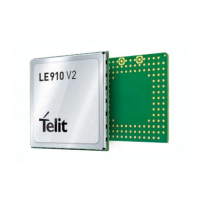Telit LE910 V2 Series AT Commands
80446ST10707A Rev. 0– 2015-11-03
Reproduction forbidden without Telit Communications S.p.A. written authorization - All Rights Reserved page 360 of 509
Mod. 0808 2011-07 Rev.2
10..5000 - hundreds of ms (factory default is 100)
Note: if secure socket is not enabled using AT#SSLEN only test requests can
be made.
Note: if timeout is not set for SSL connection the default timeout value, set by
AT#SSLCFG, is used.
Note: in online mode the socket is closed aft
er an inactivity period
(configurable with #SSLCFG, with a default value of 90 seconds), and the
‘NO CARRIER’ message is printed.
Note: in online mode data are transmitted as soon as the data packet size is
reached or as after a transmission timeout. Bot
h these parameters are
configurable by using #SSLCFG.
Note: if there are input data arrived through a connected socket and not yet
read because the module entered command mode before reading them (after
an escape sequence or after #SSLD has been issued wi
th <connMode> set to
command mode connection), these data are buffered and we receive the
SSLSRING URC (if any of its presentation formats have been enabled by
means the #SSLCFG command); it’s possible to read these data afterwards
issuing #SSLRECV. Under
the same hypotheses it’s possible to send data
while in command mode issuing #SSLSEND.
Note: Before opening a SSL connection the GPRS context must have been
activated by AT#SGACT=x,1.
Note: Before opening a SSL connection, make sure to have stored the
needed
secure data (CA certificate), using AT#SSLSECDATA.
Note: in case of CA Certificate already stored(for instance: SUPL), it could
be possible to avoid #SSLSECDATA command.
Test command returns the range of supported values for all the parameters:
#SSLD: (1),(1
-65535),,(0),(0,1),(10-5000)
Enable a SSL socket - #SSLEN
#SSLEN – Enable a SSL socket
AT#SSLEN=<SSId>,
<Enable>
This command enables a socket secured by SSL

